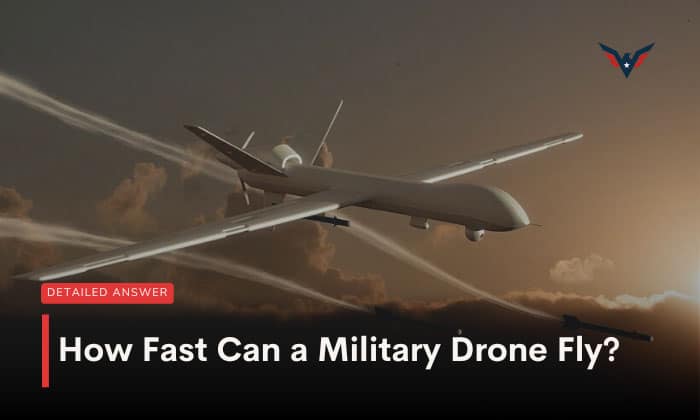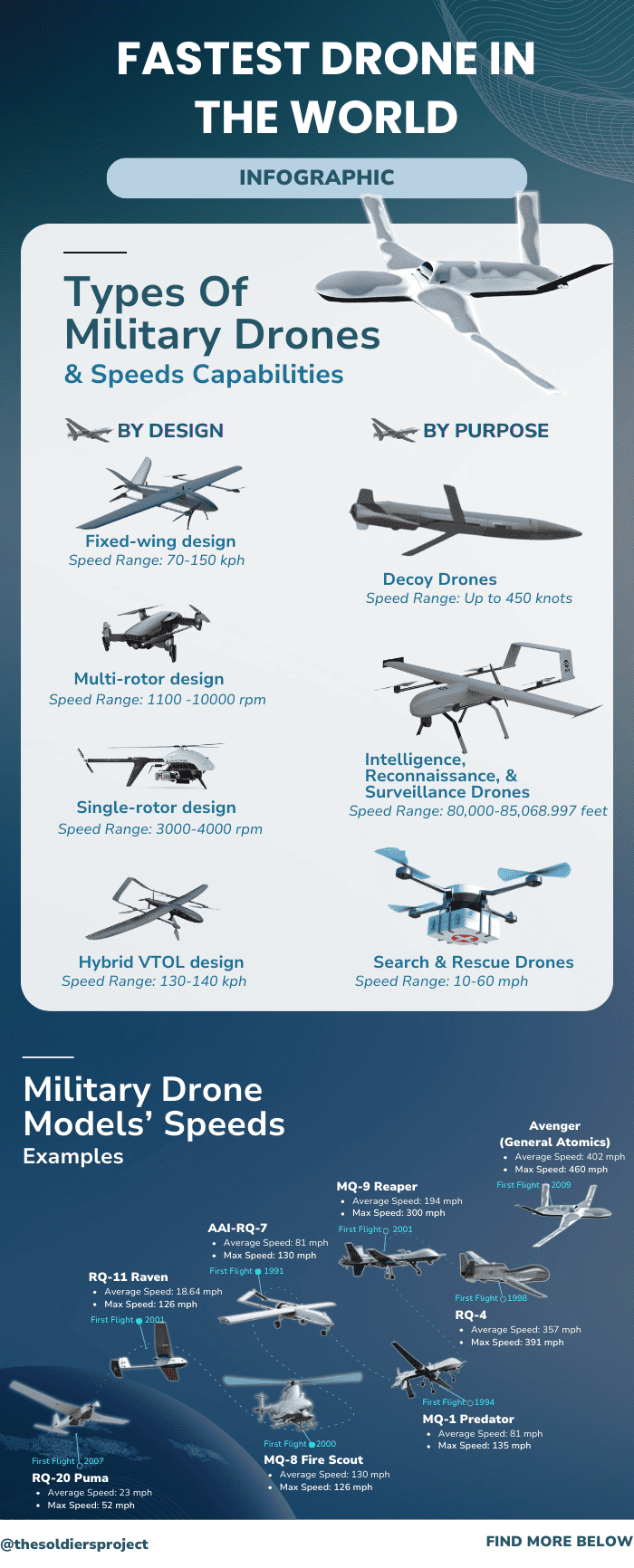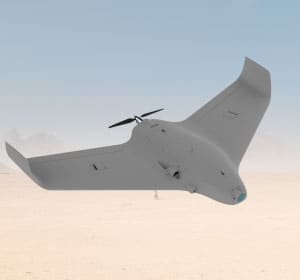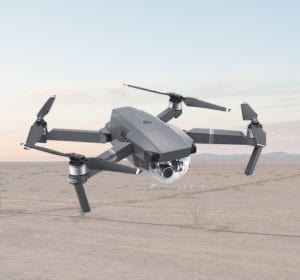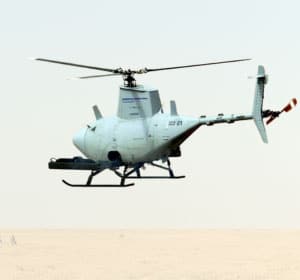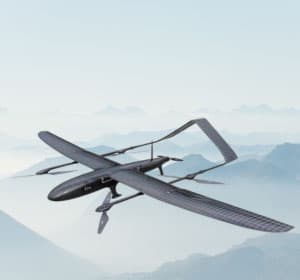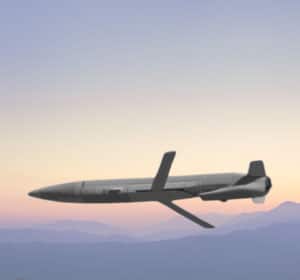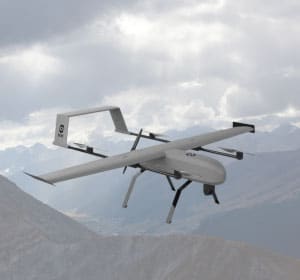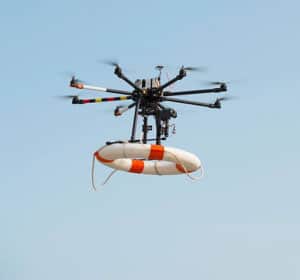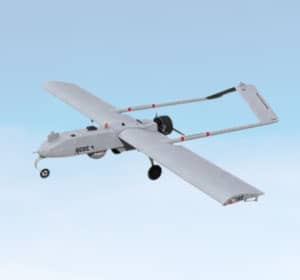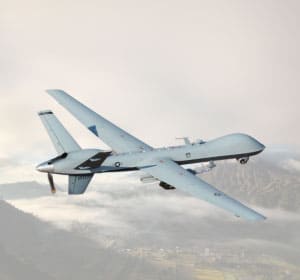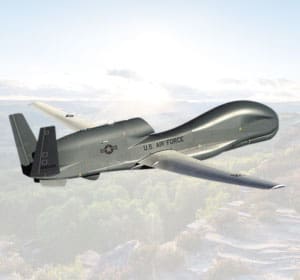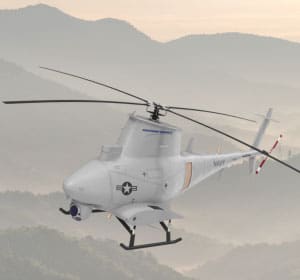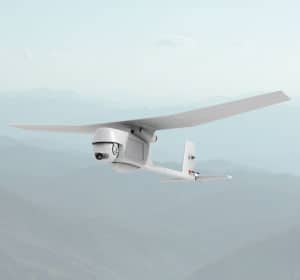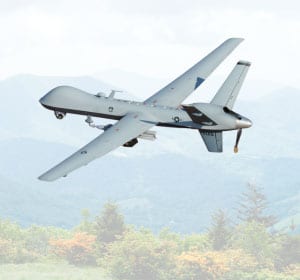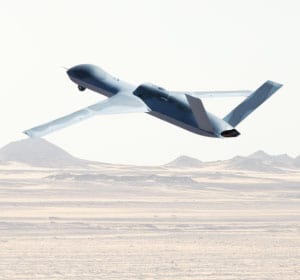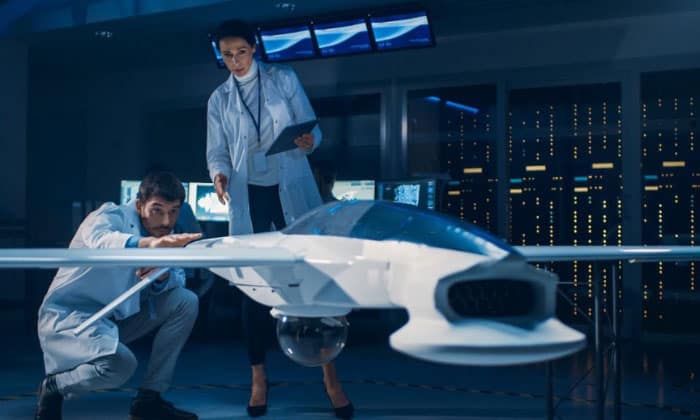Countless innovations have persistently progressed. Among them stands out a unique aerodynamic-powered apparatus with diverse applications. Reflecting on historical events, the inauguration of the pilotless vehicle and modern drone was in 1917 and 1935.
Soldiers and innovators actively developed drones for the army and commercial purposes. These devices stretch out a maximum speed of 16879.9 mph, surpassing the speed capabilities of regular commercial and racing drones.
Read for further information about how fast can a military drone fly and non-commercial drones.
Table of Contents
Types Of Military Drones And Their Speed Capabilities
Military drones possess diverse classifications based on UAV speed, design, and functions. To enhance our understanding, let’s outline the following types of drones for a more detailed analysis.
1. Categorizing military drones based on their design:
- Fixed-wing design
These drones possess wing configurations reminiscent of conventional manned commercial aircraft. These types of drones render an impressive speed range, spanning from a minimum flight speed of 70 kph to a maximum speed of 150 kph.
- Multi-rotor design:
These UAVs feature three or more propellers. Octocopters, hex copters, quadcopters, and tri-copters are examples of this according to the number of their propellers.
These types of drones possess a remarkable speed range varying from 1100 to 10000 revolutions per minute (rpm). The frequency at which the motor rotates. The identification of velocity depends on the frequency at which the motor rotates.
- Single-rotor design:
These drones have a helicopter-like appearance, with a solitary main rotor and a small tail rotor. These drones provide a speed range ranging from 3000 to 4000 revolutions per minute (RPM).
- Hybrid VTOL design:
These UAVs combine fixed-wing and rotary-blade designs, blending features of single and multi-rotor configurations into one aircraft. These drones offer a speed range that spans from 130 to 140 kilometers per hour (kph)
2. Categorizing military drones based on their purpose:
- Decoy Drones:
These drones aim to deceive or outwit anti-aircraft defense systems. Decoy drones have achieved speed records of up to 450 knots, reaching altitudes of 15,000 feet and boasting a minimum endurance of one hour.
- Intelligence, Reconnaissance, and Surveillance Drones:
These drones, classified as camera drones, feature high-quality resolution and sensors that capture data and images from a considerable distance. It serves multiple purposes, such as spotting enemies’ positions, trailing their movements, and evaluating each terrain.
These drones can reach altitudes ranging from 80,000 to 85,068.997 feet, covering an impressive area of 100,000 square miles per hour. Additionally, they can achieve speeds of up to 2,193.1669 mph.
- Search and Rescue Drones:
Troop deployment of drones enhances operational efficiency through faster delivery of essential supplies in the field. These drones cover more ground than ground search teams, leveraging airspeeds of drones with 10-60 mph, enabling effective rescue operations in dangerous or inaccessible areas.
Different Military Drone Models And Their Maximum Speeds
Drones in the military serve multiple purposes. The main benefit lies in their capacity to conduct missions and enable effective targeting without endangering personnel while minimizing harm to civilians and unintended damage.
Here are some examples of military drone models’ speeds:
1. AAI RQ-7
This drone is designed for surveillance and reconnaissance, offering vital assistance to Army operations. However, it is subject to limitations in adverse weather conditions.
The drone embarked on its maiden flight in 1991. Documented average drone speed is 81 mph, with a range of 68 miles. It can sustain 6 to 9 hours and fly at a max speed of 130 mph.
2. MQ-1 Predator
The drone made its inaugural flight in 1994. Documented average drone speed is 81 mph, with a range of 777 miles. It can sustain 24 hours and fly at a max speed of 135 mph.
3. RQ-4
The recognized biggest military drone conducted its first flight in 1998. Documented average drone speed is 357 mph, with a range of 14,200 miles. It can sustain 32+ hours and fly at a top speed of 391 mph.
4. MQ-8 Fire Scout
This high-speed drone made its debut flight in 2000. Documented average drone speed is 130mph, with a range of 126 miles. It can sustain 8 hours and fly at a maximum speed of 126 mph.
5. RQ-11 Raven
The drone embarked on its first flight in 2001. Documented average drone speed is 18.64mph, with a range of 6.2 miles. It can sustain 60-90 minutes and its fastest drone speed of 126 mph.
6. MQ-9 Reaper
The Reaper drone conducted its first flight in 2001. Documented average drone speed is 194 mph, with a range of 1,200 miles. It can sustain 14 hours and fly at a maximum speed of 300 mph.
7. RQ-20 Puma
The drone took to the skies for the first time in 2007. Documented average drone speed is 23 mph, with a range of 9.3 miles. It can sustain 2 hours and fly at a peak speed of 52 mph.
8. Avenger (General Atomics)
The drone made its debut flight in 2009. Documented average drone speed is 402mph, with a range of 15,240 miles. It can sustain 18 hours and fly at a maximum speed of 460 mph.
The Fastest Military Drone
The Darpa Falcon HTV-2 claims The record for being the fastest unmanned aircraft. Yet, the world’s fastest drone title belongs to the DRL RaceX, boasting an impressive top speed of 165.2 mph.
Please refer to the chart below to take a deeper look into the other military drones claiming the title of the swift speed in the world.
FASTEST MILITARY DRONES
| DRONE | MAXIMUM SPEED | DRONE | MAXIMUM SPEED | ||
| 1 | Falcon Hypersonic Technology Vehicle (HTV) 2 | Mach 22 | 12 | X-45A | Mach 0.75 |
| 2 | Falcon Hypersonic Technology | Mach 20 | 13 | Avenger [Predator C] | Mach 0.6 |
| 3 | Extreme Speed Velociraptor | Mach 10 | 14 | RQ-4 Global Hawk | Mach 0.51 |
| 4 | Northrop Grumman Bat M | Mach 6+ | 15 | MQ-9B SkyGuardian | Mach 0.32 |
| 5 | SR-72 | Mach 6 | 16 | Camcopter S-100 | Mach 0.31 |
| 6 | Boeing Phantom Ray | Mach 3 | 17 | Super Heron | Mach 0.23 |
| 7 | QF-16 | Mach 2 | 18 | MQ-1 Predator | Mach 0.18 |
| 8 | Lockheed Martin F-35 Lightning Ii Joint Strike Fighter | Mach 1.6 | 19 | Rustom-H | Mach 0.18 |
| 9 | North Grumman X-47B | >Mach 0.91 | 20 | Lockheed Martin SR-72 Blackbird | 7,500 mph |
| 10 | Dassault Neuron | Mach 0.91 | 21 | Mq-9 Reaper | 300 mph |
| 11 | Taranis | Mach 0.9 | 22 | Boeing V-22 Osprey | 200 mph |
Factors That Affect the Speed of Military Drones
Various elements can impact the speed of drones, including their size and weight, design, operating altitude, method of propulsion, and prevailing weather conditions. These factors greatly contribute to determining the velocity capabilities of drones.
- The physique of a UAV directly affects its velocity, as the technology relies on the scope of the drone’s body.
- Heavier weight can result in a decrease in speed for the drone.
- The design of a drone plays a vital role in its speed, as factors such as wing configuration and propulsion method directly influence its velocity. As altitude increases, the drone encounters reduced oxygen levels and experiences minimal air resistance, resulting in increased speed.
- Drones equipped with high-power propulsion systems have a significant impact on improving their speed capabilities.
- Severe weather conditions, characterized by heavy rain and strong winds, can significantly disrupt the drone’s system and seriously hamper its speed.
Speed Differences Between Military And Commercial Drones
Military drones differ significantly from commercial drones, with one notable distinction being the encryption of data, which restricts public access. This measure primarily aims to ensure public safety.
Commercial and military drones have a significant speed comparison. Military drones are notably faster than consumer drones when it comes to velocity.
Military drones can reach a top speed of 16879.9 mph, surpassing the speed range of regular commercial drones, which typically fall between 40-70 mph. Additionally, racing drones can achieve a velocity ranging from 100-165 mph.
Conclusion
To summarize, soldiers employ diverse drones for different missions and locations. This article has provided insights into the speed capabilities of military drones and an overview of various drone types. Moreover, you have acquired knowledge that drones undergo classification based on their speed, design, and intended purpose.
Aside from answering, how fast can a military drone fly, we have also touched base on the difference in speed between commercial and military drones. We also discussed the fastest military drones in the world. If you found this article informative and engaging, Keep an eye out for upcoming content.

I am Everett Bledsoe, taking on the responsibility of content producer for The Soldiers Project. My purpose in this project is to give honest reviews on the gear utilized and tested over time. Of course, you cannot go wrong when checking out our package of information and guide, too, as they come from reliable sources and years of experience.

